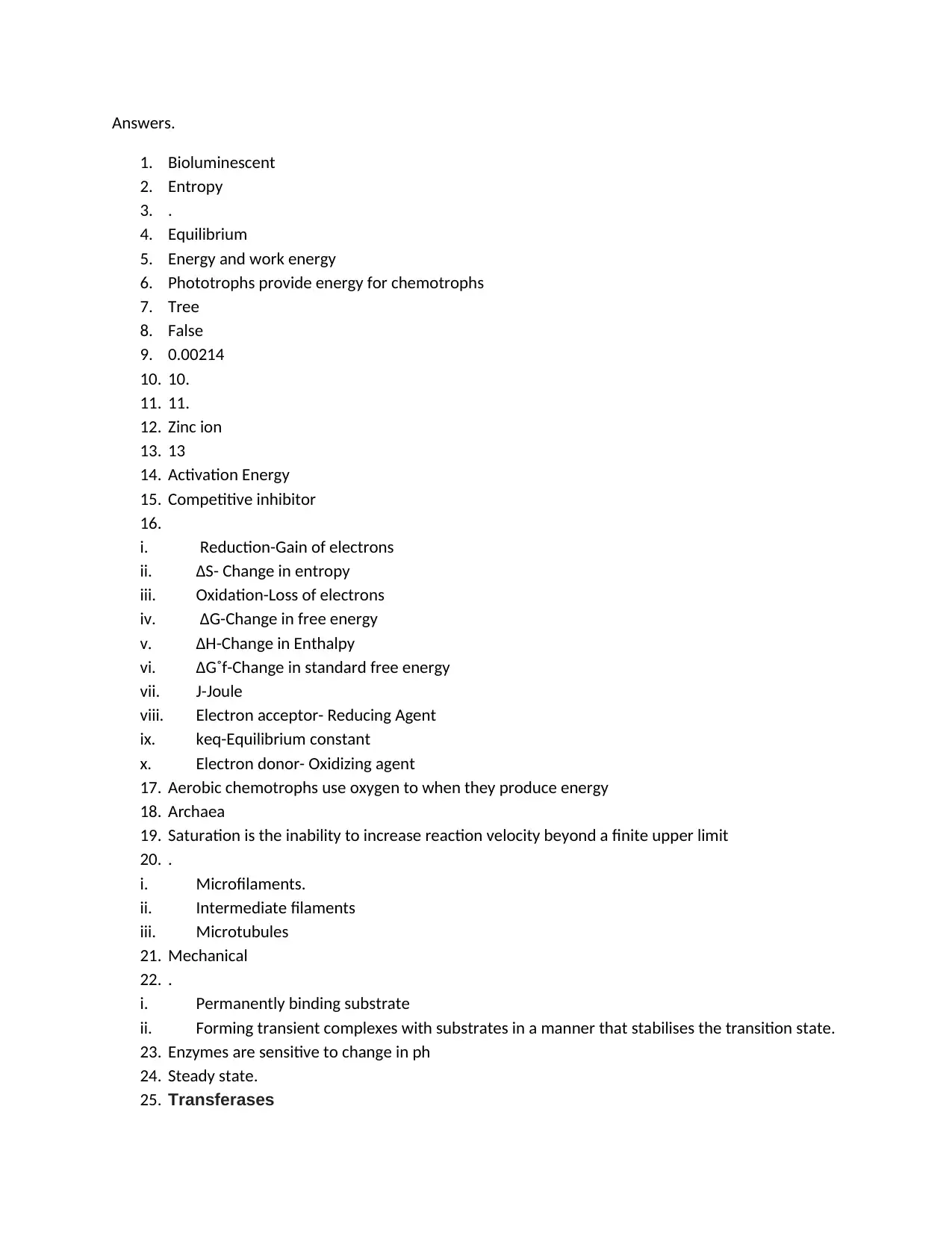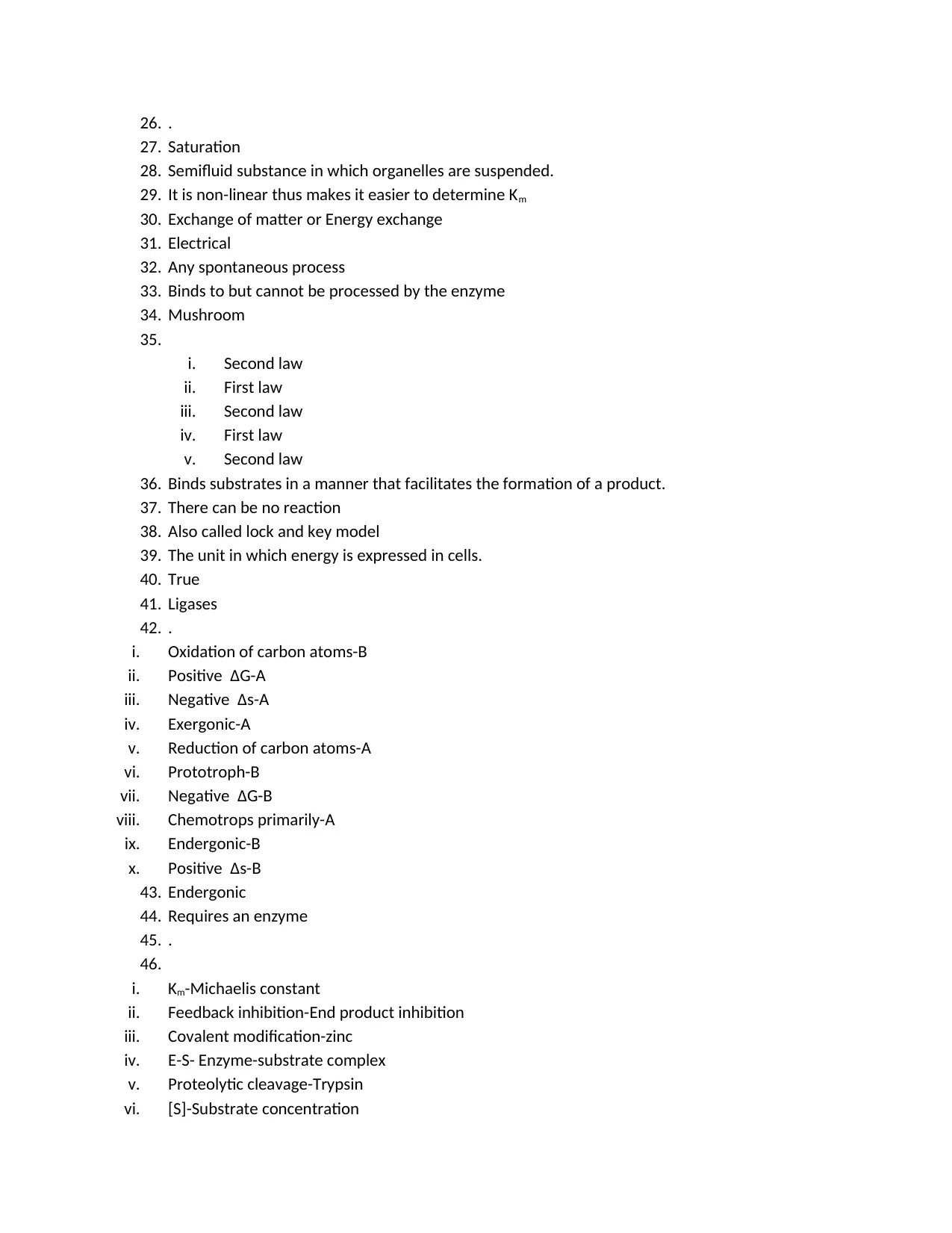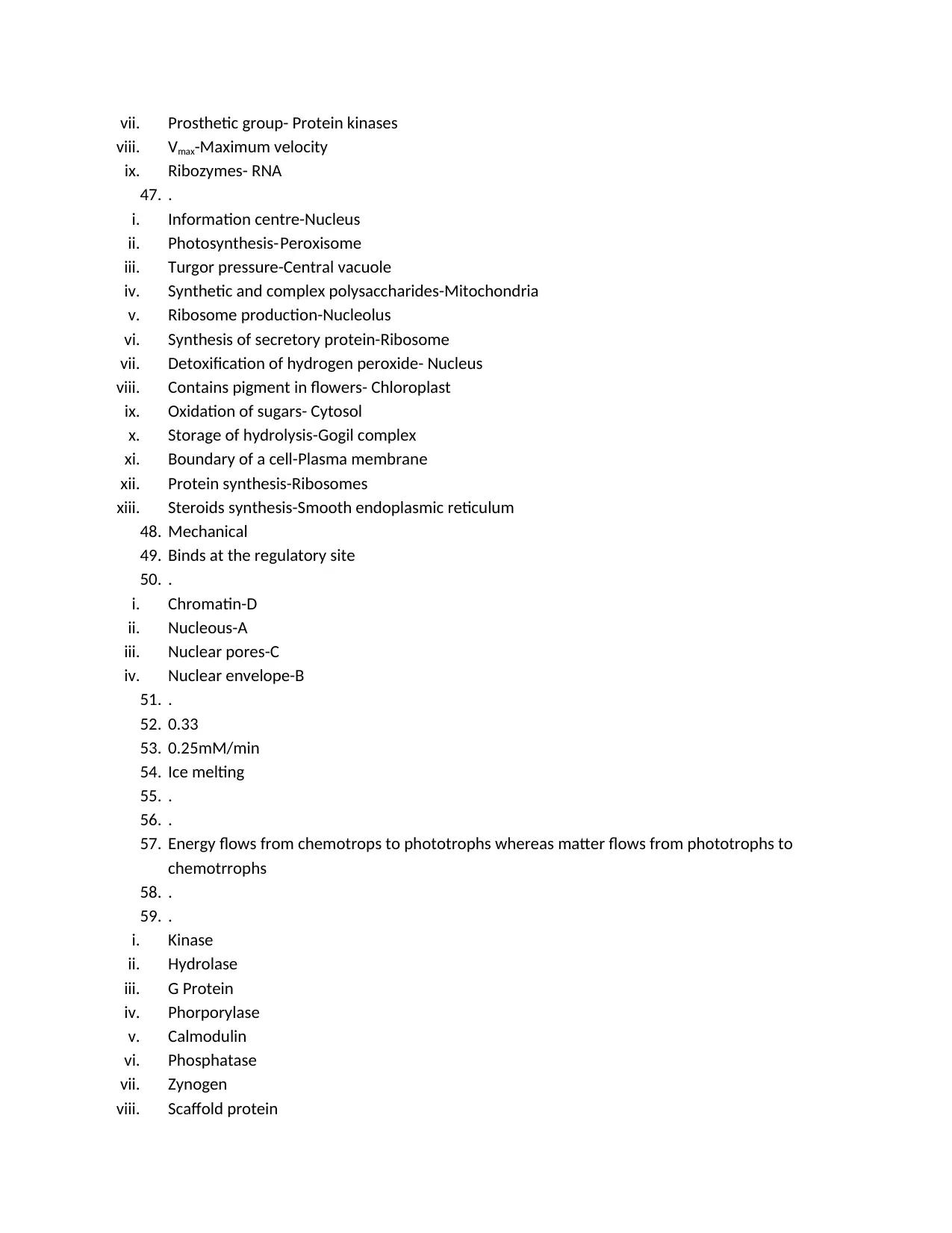Assignment about What is Bioluminescent ?
VerifiedAdded on 2022/09/28
|4
|363
|19
Assignment
AI Summary
Contribute Materials
Your contribution can guide someone’s learning journey. Share your
documents today.

Answers.
1. Bioluminescent
2. Entropy
3. .
4. Equilibrium
5. Energy and work energy
6. Phototrophs provide energy for chemotrophs
7. Tree
8. False
9. 0.00214
10. 10.
11. 11.
12. Zinc ion
13. 13
14. Activation Energy
15. Competitive inhibitor
16.
i. Reduction-Gain of electrons
ii. ∆S- Change in entropy
iii. Oxidation-Loss of electrons
iv. ∆G-Change in free energy
v. ΔH-Change in Enthalpy
vi. ΔG˚f-Change in standard free energy
vii. J-Joule
viii. Electron acceptor- Reducing Agent
ix. keq-Equilibrium constant
x. Electron donor- Oxidizing agent
17. Aerobic chemotrophs use oxygen to when they produce energy
18. Archaea
19. Saturation is the inability to increase reaction velocity beyond a finite upper limit
20. .
i. Microfilaments.
ii. Intermediate filaments
iii. Microtubules
21. Mechanical
22. .
i. Permanently binding substrate
ii. Forming transient complexes with substrates in a manner that stabilises the transition state.
23. Enzymes are sensitive to change in ph
24. Steady state.
25. Transferases
1. Bioluminescent
2. Entropy
3. .
4. Equilibrium
5. Energy and work energy
6. Phototrophs provide energy for chemotrophs
7. Tree
8. False
9. 0.00214
10. 10.
11. 11.
12. Zinc ion
13. 13
14. Activation Energy
15. Competitive inhibitor
16.
i. Reduction-Gain of electrons
ii. ∆S- Change in entropy
iii. Oxidation-Loss of electrons
iv. ∆G-Change in free energy
v. ΔH-Change in Enthalpy
vi. ΔG˚f-Change in standard free energy
vii. J-Joule
viii. Electron acceptor- Reducing Agent
ix. keq-Equilibrium constant
x. Electron donor- Oxidizing agent
17. Aerobic chemotrophs use oxygen to when they produce energy
18. Archaea
19. Saturation is the inability to increase reaction velocity beyond a finite upper limit
20. .
i. Microfilaments.
ii. Intermediate filaments
iii. Microtubules
21. Mechanical
22. .
i. Permanently binding substrate
ii. Forming transient complexes with substrates in a manner that stabilises the transition state.
23. Enzymes are sensitive to change in ph
24. Steady state.
25. Transferases
Secure Best Marks with AI Grader
Need help grading? Try our AI Grader for instant feedback on your assignments.

26. .
27. Saturation
28. Semifluid substance in which organelles are suspended.
29. It is non-linear thus makes it easier to determine Km
30. Exchange of matter or Energy exchange
31. Electrical
32. Any spontaneous process
33. Binds to but cannot be processed by the enzyme
34. Mushroom
35.
i. Second law
ii. First law
iii. Second law
iv. First law
v. Second law
36. Binds substrates in a manner that facilitates the formation of a product.
37. There can be no reaction
38. Also called lock and key model
39. The unit in which energy is expressed in cells.
40. True
41. Ligases
42. .
i. Oxidation of carbon atoms-B
ii. Positive ∆G-A
iii. Negative ∆s-A
iv. Exergonic-A
v. Reduction of carbon atoms-A
vi. Prototroph-B
vii. Negative ∆G-B
viii. Chemotrops primarily-A
ix. Endergonic-B
x. Positive ∆s-B
43. Endergonic
44. Requires an enzyme
45. .
46.
i. Km-Michaelis constant
ii. Feedback inhibition-End product inhibition
iii. Covalent modification-zinc
iv. E-S- Enzyme-substrate complex
v. Proteolytic cleavage-Trypsin
vi. [S]-Substrate concentration
27. Saturation
28. Semifluid substance in which organelles are suspended.
29. It is non-linear thus makes it easier to determine Km
30. Exchange of matter or Energy exchange
31. Electrical
32. Any spontaneous process
33. Binds to but cannot be processed by the enzyme
34. Mushroom
35.
i. Second law
ii. First law
iii. Second law
iv. First law
v. Second law
36. Binds substrates in a manner that facilitates the formation of a product.
37. There can be no reaction
38. Also called lock and key model
39. The unit in which energy is expressed in cells.
40. True
41. Ligases
42. .
i. Oxidation of carbon atoms-B
ii. Positive ∆G-A
iii. Negative ∆s-A
iv. Exergonic-A
v. Reduction of carbon atoms-A
vi. Prototroph-B
vii. Negative ∆G-B
viii. Chemotrops primarily-A
ix. Endergonic-B
x. Positive ∆s-B
43. Endergonic
44. Requires an enzyme
45. .
46.
i. Km-Michaelis constant
ii. Feedback inhibition-End product inhibition
iii. Covalent modification-zinc
iv. E-S- Enzyme-substrate complex
v. Proteolytic cleavage-Trypsin
vi. [S]-Substrate concentration

vii. Prosthetic group- Protein kinases
viii. Vmax-Maximum velocity
ix. Ribozymes- RNA
47. .
i. Information centre-Nucleus
ii. Photosynthesis-Peroxisome
iii. Turgor pressure-Central vacuole
iv. Synthetic and complex polysaccharides-Mitochondria
v. Ribosome production-Nucleolus
vi. Synthesis of secretory protein-Ribosome
vii. Detoxification of hydrogen peroxide- Nucleus
viii. Contains pigment in flowers- Chloroplast
ix. Oxidation of sugars- Cytosol
x. Storage of hydrolysis-Gogil complex
xi. Boundary of a cell-Plasma membrane
xii. Protein synthesis-Ribosomes
xiii. Steroids synthesis-Smooth endoplasmic reticulum
48. Mechanical
49. Binds at the regulatory site
50. .
i. Chromatin-D
ii. Nucleous-A
iii. Nuclear pores-C
iv. Nuclear envelope-B
51. .
52. 0.33
53. 0.25mM/min
54. Ice melting
55. .
56. .
57. Energy flows from chemotrops to phototrophs whereas matter flows from phototrophs to
chemotrrophs
58. .
59. .
i. Kinase
ii. Hydrolase
iii. G Protein
iv. Phorporylase
v. Calmodulin
vi. Phosphatase
vii. Zynogen
viii. Scaffold protein
viii. Vmax-Maximum velocity
ix. Ribozymes- RNA
47. .
i. Information centre-Nucleus
ii. Photosynthesis-Peroxisome
iii. Turgor pressure-Central vacuole
iv. Synthetic and complex polysaccharides-Mitochondria
v. Ribosome production-Nucleolus
vi. Synthesis of secretory protein-Ribosome
vii. Detoxification of hydrogen peroxide- Nucleus
viii. Contains pigment in flowers- Chloroplast
ix. Oxidation of sugars- Cytosol
x. Storage of hydrolysis-Gogil complex
xi. Boundary of a cell-Plasma membrane
xii. Protein synthesis-Ribosomes
xiii. Steroids synthesis-Smooth endoplasmic reticulum
48. Mechanical
49. Binds at the regulatory site
50. .
i. Chromatin-D
ii. Nucleous-A
iii. Nuclear pores-C
iv. Nuclear envelope-B
51. .
52. 0.33
53. 0.25mM/min
54. Ice melting
55. .
56. .
57. Energy flows from chemotrops to phototrophs whereas matter flows from phototrophs to
chemotrrophs
58. .
59. .
i. Kinase
ii. Hydrolase
iii. G Protein
iv. Phorporylase
v. Calmodulin
vi. Phosphatase
vii. Zynogen
viii. Scaffold protein

60. Has to occur immediately
61. .
62. All above answers are true
61. .
62. All above answers are true
1 out of 4
Your All-in-One AI-Powered Toolkit for Academic Success.
+13062052269
info@desklib.com
Available 24*7 on WhatsApp / Email
![[object Object]](/_next/static/media/star-bottom.7253800d.svg)
Unlock your academic potential
© 2024 | Zucol Services PVT LTD | All rights reserved.